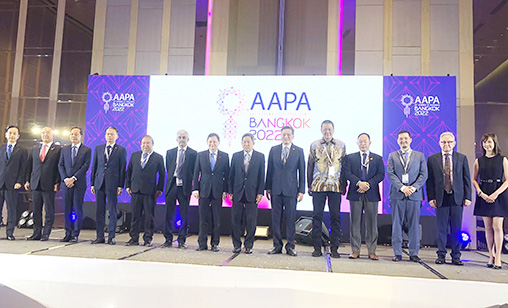Main Story
Air India boosts industry heft of Asia-Pacific airline association
When the bosses of the region’s major airlines met in Bangkok last month for the 66th Assembly of Presidents of the Association of Asia Pacific Airlines (AAPA) there was collective relief that air traffic is surging and pandemic recovery is underway. There also was a significant development at the gathering, associate editor and chief correspondent, Tom Ballantyne, reports.
December 1st 2022
For years, the ranks of the Association of Asia Pacific Airlines (AAPA) have been shrinking. Read More » From some 17 members in the 1990s, AAPA member airlines stood at 13 in October. Qantas Airways withdrew in 2010, followed by Air New Zealand, Vietnam Airlines and most recently, Korean Air.
Air Astana joined up in 2014, but years of effort to attract Chinese and Indian carriers as airline members had come to nothing. So it was a surprise to see Air India CEO, Campbell Wilson, at the Assembly in Bangkok. “As an observer,” he told Orient Aviation. Within days of the close of the gathering, Air India was announced as a new AAPA airline member, with immediate effect.
 |
“It is an honour for the AAPA to welcome Air India into our ranks as the first Indian airline to join the association. Air India operated its first flight in 1932 in India, which represents one of the largest civil aviation markets in the world. The airline will add considerable weight to the international aviation discourse undertaken by the AAPA on behalf of Asia-Pacific airlines,” AAPA director general, Subhas Menon, said.
All the membership resignations occurred before Menon took the top AAPA job in March 2020 – as the pandemic was escalating. Now he appears confident Air India will not be the end of the association’s membership expansion. Although no announcement has been made, it was interesting to note non-member Vietnam Airlines also had representatives at the Assembly.
Are efforts being made to convince members who have left to return to the fold? “Looking back at the history, we have had different membership over the years. Some come and some go, depending on changing circumstances,” Menon said.
“But whenever we speak, we speak for the whole Asia-Pacific airline community. Many of our working groups, especially safety, are open to all airlines and many non-members attend our meetings. We believe we provide value and we provide benefits for the entire airline community.
“We are always – I would not say on the prowl – but we are always looking for opportunities to extend our membership. We have been very active on this front in the last few months. We have been talking to different airlines, the ones you mentioned, including airlines that have left. We are trying to bring them back as well.
“Also, we are open to no-frills airlines. We are trying to expand our membership and are open to all business models. We want to be an association that represents the airline industry, irrespective of size, location and business model.”
In the meantime, the Assembly welcomed the resumption of international air travel, which has surged as the region’s governments have gradually removed border restrictions imposed since 2020. As cross-border travel is progressively restored, regional carriers have raced to restore flights to meet runaway demand, stimulated by the pent-up desire to travel, savings accumulated in the past two years plus of isolation.
In the first nine months of 2022, Asia-Pacific airlines recorded a more than five-fold increase in international passenger numbers, to 62 million, compared with the same period in 2021. Consequently, with capacity expanding by 125% in the same period, international passenger load factor jumped by 40% to an average 70%.
 |
Airlines are “cautiously optimistic” about the future, but also well aware that challenges are ahead, notably a weakened macro-economic outlook, rising inflation in many countries, stubbornly high energy prices and a strengthening U.S. dollar.
Their major worry is the high cost of fuel. “Fuel supply is being restricted. Saudi Arabia and Russia are trying to limit supplies, so it is a major concern,” said Menon.
Air cargo markets, often an indicator of the global economy’s trends, also are a cause for some concern. Demand, measured in international freight tonne kilometers (FTK), fell by 4.4% in the nine months to September 30, as export orders waned and supply chain problems mounted.
Menon said prospects for the region’s airlines remain promising as long as pent-up demand continues to hold up and cargo yields remain healthy despite the easing of demand.
Reflecting sentiment at the Assembly, Menon observed: “The region’s recovery still lags behind the rest of the world and is expected to reach only 75% of 2019 levels by year-end. Except for mainland China, the gradual re-opening of borders in many economies in Asia and a strong recovery in air services serve to underscore the magnitude of pent-up travel demand.”
Among resolutions passed by the Assembly was one that noted the proliferation of onerous regulations imposed on the air transport industry during the pandemic. AAPA airline leaders stressed the critical importance of governments adopting a more coordinated approach to ensure the speedy recovery of the sector in the coming months.
“AAPA carriers have shown great resilience in confronting the challenges brought about by the prolonged COVID-19 pandemic, while maintaining the highest safety standards,” Menon said. “However, the lack of coordination of travel requirements across borders and the burden of restrictive government regulations, is holding back the sustainable recovery and growth of Asia's carriers and their ability to fully contribute to the social and economic development of the region.”
Another area of serious concern for the region’s carriers is unilateral regulations introduced by national/regional aviation regulators who are failing to take into account the international nature of airline operations.
In the current instance, the U.S. Federal Aviation Administration (FAA) now requires all commercial aircraft to be retrofitted with new or modified radio altimeters by July 2023 to maintain their operations to the U.S.
The ruling’s purpose is to allow telecommunications companies to power up their 5G networks to the full capacity authorized by the Federal Communications Commission, even as the full effects of 5G on aircraft operations are still being studied.
Unresolved spectrum issues relating to aeronautical safety services have resulted in flight cancellations, degradations of air traffic management services and interruptions of flight operations.
A comprehensive frequency spectrum strategy, in line with ICAO Standards and Recommended Principles (SARPs), is required to support timely availability and protection of adequate spectrum for civil aviation, the association argues.
AAPA believes introducing regulations to meet specific regional or sectoral goals that are counterproductive to aviation safety and recovery is not in keeping with ICAO’s “no country left behind” principle.
AAPA called on governments, aviation regulators, safety agencies and other stakeholders to support the ICAO frequency spectrum strategy. AAPA also asked governments to consult with aviation safety regulators, subject matter experts and airspace users, to provide all necessary considerations and establish regulatory measures to ensure incumbent aviation systems and services are free from harmful interference.
wayne murray says:
August 8th 2024 02:57pm